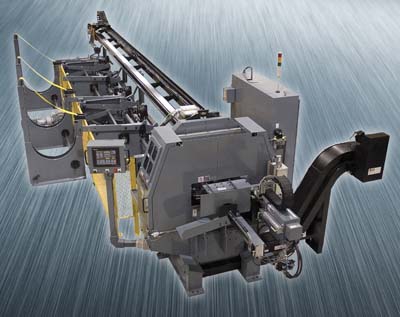
Bardons & Oliver introduces a new generation RH-700 Rotating Head Cut-Off Machine. This new RH-700 Rotating Head Cut-Off Machine can achieve 45-50 square inches per minute or more on high production heavy-wall tube processing. The RH-700 increases efficiency because it can use four tools simultaneously. It can provide a constant feed rate and it minimizes non-cut time by tailoring material handling equipment to the process. Less material loss is accomplished through precision length tolerance control.
Featuring a rotating head with four precision-built hardened tool steel cut-off slides and gibs with 8620 alloy steel bases mounted onto the rotating head, the RH-700 also features a quick set-up tube loader, an optional mist coolant system, and a central lubrication system. Unlike a conventional cut-off lathe, Bardons & Oliver's RH-700 Rotating Head Cut-Off Machines hold the material stationary while the cutting tools rotate. This feature means that lathe style cut-off techniques can be used for a broader range of applications and difficult-to-process materials like irregular tubes and bars can be processed more efficiently.
Contact Details
Related Glossary Terms
- coolant
coolant
Fluid that reduces temperature buildup at the tool/workpiece interface during machining. Normally takes the form of a liquid such as soluble or chemical mixtures (semisynthetic, synthetic) but can be pressurized air or other gas. Because of water’s ability to absorb great quantities of heat, it is widely used as a coolant and vehicle for various cutting compounds, with the water-to-compound ratio varying with the machining task. See cutting fluid; semisynthetic cutting fluid; soluble-oil cutting fluid; synthetic cutting fluid.
- feed
feed
Rate of change of position of the tool as a whole, relative to the workpiece while cutting.
- inches per minute ( ipm)
inches per minute ( ipm)
Value that refers to how far the workpiece or cutter advances linearly in 1 minute, defined as: ipm = ipt 5 number of effective teeth 5 rpm. Also known as the table feed or machine feed.
- lathe
lathe
Turning machine capable of sawing, milling, grinding, gear-cutting, drilling, reaming, boring, threading, facing, chamfering, grooving, knurling, spinning, parting, necking, taper-cutting, and cam- and eccentric-cutting, as well as step- and straight-turning. Comes in a variety of forms, ranging from manual to semiautomatic to fully automatic, with major types being engine lathes, turning and contouring lathes, turret lathes and numerical-control lathes. The engine lathe consists of a headstock and spindle, tailstock, bed, carriage (complete with apron) and cross slides. Features include gear- (speed) and feed-selector levers, toolpost, compound rest, lead screw and reversing lead screw, threading dial and rapid-traverse lever. Special lathe types include through-the-spindle, camshaft and crankshaft, brake drum and rotor, spinning and gun-barrel machines. Toolroom and bench lathes are used for precision work; the former for tool-and-die work and similar tasks, the latter for small workpieces (instruments, watches), normally without a power feed. Models are typically designated according to their “swing,” or the largest-diameter workpiece that can be rotated; bed length, or the distance between centers; and horsepower generated. See turning machine.
- tolerance
tolerance
Minimum and maximum amount a workpiece dimension is allowed to vary from a set standard and still be acceptable.








